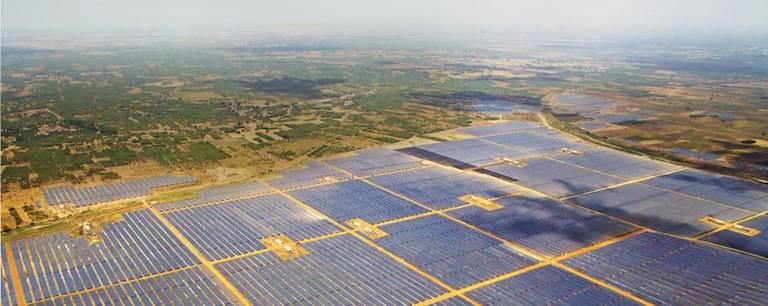
By Joseph Kirschke
India is the world’s fastest-growing energy consumer and a global leader in clean energy -- third only to China and the U.S. And by 2035, when non-fossil fuel capacity surges from 22 to 54 percent, India will have reached critical mass as the planet’s most populous nation.
India’s 1.3 billion people also offer investors an unprecedented opportunity to scale climate resilient communities, commerce, and industry in one of the world’s most dynamic emerging market economies where up to 460 million must survive without electricity.
And with prolific metals, minerals, and fuels including iron, steel, coal, lignite, aluminum and bauxite, one of the world’s largest mining industries offers a fast-evolving solution.
India’s government, with international help, is pushing hard for renewables: In fact, new coal-fired power plants are on hold until 2022 – the year 175 gigawatt of solar and wind power are projected to come online. Meanwhile, energy needs for India’s power-hungry mines remain at a premium.
Last month, state-owned National Aluminium Company Ltd. announced plans for 150 megawatts in solar and wind power. London-listed multinational Vedanta Resources had already entered the country's solar sector by bidding for 500 MW in projects; then, in December, subsidiary Hindustan Zinc pledged solar deployments of 115 MW in addition to currently installed 474 MW of thermal power and 274 MW of wind.
Indian mining companies aren’t alone: Since 2011, mines worldwide are economizing through alternative energy. This subsector, expanding in Chile, Canada, Australia and Africa, is poised to save billions as installations are forecast to quadruple to $3.9 billion within five years.
Fossil fuels were the backbone of India’s commodity-driven supercycle of the 2000s which, together with China’s, was the greatest in modern history. Amid mounting smog, heat waves and droughts – and collapsing prices for clean technology – Indian coal and oil firms are now unlikely allies with solar.
Coal India Ltd., the world’s largest state-owned coal miner, is planning more than 600 MW of solar in four states, while NLC India Ltd. has tendered for 260 MW of grid-connected solar in two. Oil giants Indian Oil Corp. and Oil India Ltd. have similarly permitted a 1 GW solar farm.
But the true potential lies in integrating these deployments with existing clean-energy distribution in regions home to at least a third of the world’s population living without electricity. A prime example is India’s high-voltage Green Energy Corridor underwritten by the Asian Development Bank (ADB) which, despite some success, has officials concerned over uneven penetration in the poor states it aims to benefit.
Madhya Pradesh, where Coal India has signed for 200 MW of solar, is one. Rajasthan, home to India’s largest single deposit of lead, zinc and silver – and where Hindustan Zinc commissioned 15 MW of solar late last year – is another. Elsewhere, in Andhra Pradesh, Tata Power Renewable Energy Ltd. operates a 100 MW wind farm.
In Gujarat, Gujarat Mineral Development Corp. installed a 5 MW solar farm at a reclaimed mine. And in Maharashtra, under the U.N. Framework Convention on Climate Chang (UNFCCC), the renewable energy division of iron ore producer Essel Mining and Industries Ltd. installed 75 MW of wind in exchange for carbon credits.
The industrial-scale infrastructure associated with India's mechanized mines -- including extensive transportation systems -- hold promise, too. In particular, efforts are underway to green segments of India’s railway network – one of the world’s largest – which consumes more diesel and electricity than any other part of the economy.
Indeed, as climate change is being recognized as an existential threat, India has seldom held more appeal for international asset managers – even among some of the biggest, normally risk-averse institutional investors like pension funds, banks and insurance firms. Yet amid green bonds, climate funds and other inventive mechanisms, large financiers still grapple with cohesive approaches.
Perhaps most onerous is India's lack of development coupled with erratic policies and regulations. But a flexible and burgeoning impact investment market can stimulate matching finance from development agencies, lenders and large institutions. Take the Rockefeller Foundation's Smart Power India initiative, the country’s largest “anchor-based” network encompassing telecommunications towers, which seeks to spread clean energy to 1,000 rural Indian villages this year.
Acumen is also India-focused and invests millions in off-grid clean energy for homes and businesses; Frontier Markets, a Rajasthan-based for-profit, seeks to provide clean energy access to 1 million Indian households by 2020. Last week, reports emerged private equity fund Actis will invest $500 million into a successful bidder for a World Bank-financed 750 MW solar park.
One nonprofit is advancing this narrative, if quietly, through a unique human capital approach.
Barefoot College is a pioneer which trains women from across the global south to become solar engineers and educators. After sponsoring their travel, the NGO -- also Rajasthan-based -- enabled participants from 77 countries to bring newfound technical skills back to their local communities.
One returned home to Ollagüe, Chile, where Italy’s Enel Green Power installed a solar plant with more than 1,600 photovoltaic panels through a partnership with Phoenix-based mining giant Freeport McMoRan Inc. Now the 150 families of the indigenous Quechua community are enjoying their first ongoing supply of electric power.
For all the challenges inherent in its extreme poverty, India is blessed with mineral resources, clean energy and an entrepreneurial spirit which may make it the planet's ideal ecosystem in the fight against industrial carbon emissions.
And for investors striving to enact change through COP21 and its $13.5 trillion commitments, it cannot be overlooked.
Image courtesy of the author
Joseph Kirschke is a consultant who advises mining companies on sustainability and clean energy, is a former editor at Mining Media International, a Jacksonville-based publishing house
TriplePundit has published articles from over 1000 contributors. If you'd like to be a guest author, please get in touch!














